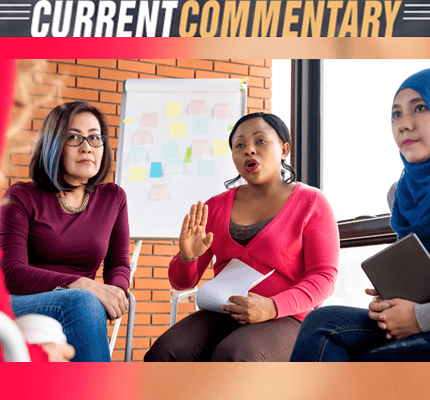
The Promise and Perils of Interracial Dialogue
By Srividya Ramasubramanian, Ph.D., and Anna Wolfe, Ph.D.
George Floyd, Breonna Taylor, Ahmaud Arbery, and so many others. The gruesome murders of Black people by police officers and white vigilantes have sparked uprisings across the United States, with participants calling for racial justice, revolution, and large-scale changes to address systemic racism. In light of these events, more white and non-Black people of color are looking for antiracism resources to educate themselves about anti-Blackness. There seems to be a greater willingness to talk honestly about racial injustice and inequities in our country. At this pivotal moment, interracial dialogue may be a critical piece of our collective healing. This essay explores how a trauma-centered approach to interracial dialogues, with a focus on collaborative action, may serve as a tool for social change, while also reflecting on the limitations and challenges of such dialogues.
As a distinct quality of communication, dialogue focuses on building understanding, deeply exploring ideas, and transforming perceptions of divisive conflict toward intergroup collaboration. Dialogic moments are interactional accomplishments of profound awareness of self and other that facilitate connection across social identities and materialize opportunities for new constructions of collectivity (Wolfe, 2018). At its best, dialogue promises to bring together people with different worldviews, life experiences, stakes, interests, and goals and provide opportunities for perspective-taking, learning, open-mindedness, and turn-taking.
In our own work with the Difficult Dialogues Project, we use dialogues to bring together people from multiple races, majors, and backgrounds to engage in structured conversations about difficult topics, including racism, especially anti-Blackness. These sessions use shared ground rules, are often guided by trained facilitators, and are based on values of active listening, empathy building, mutual respect, and a commitment to collective action (Ramasubramanian, Sousa, & Gonlin, 2017). We draw on our experiences in conducting several anti-racism workshops since 2016, including virtual ones, using a conversation café, small group dialogue format.
However, dialogue is subject to many critiques. Dialogue can be criticized as “just talk” when coming together to discuss difficult problems with a diverse group of people is treated as a means to an end, rather than a means to social action. When calls for dialogue seek to tame uncivil tongues (Lozano-Reich & Cloud, 2009) with “politeness” norms and tone policing, strong emotions such as outrage and grief are silenced and the forum is complicit in supporting the status quo. In the context of #BlackLivesMatter uprisings and institutional changes within the academe, the first author has written about some ways in which white allies can support Black Lives, departments can respond to racial inequalities, and progress can be made toward concrete collective action.
It is important to consider how the context of the dialogue shapes understandings of and experiences with oppression, power, and privilege. If not designed well, dialogues can perpetuate misunderstandings, result in silence, create tension, and bring about feelings of anxiety, anger, and awkwardness (Gayles et al., 2015; Sue & Constantine, 2007). Therefore, it is important to consider contextual elements such as power differences, amount of structure, and group composition. For example, we are intentional in selecting co-facilitators who have demonstrated commitment to anti-racism work. The everyday lived experiences of attendees and facilitators should be valued.
Dialogues can be helpful in searching for understanding, creating space for telling stories, and sharing personal experiences. In other words, engaging in dialogic exploration with open-mindedness by suspending prior beliefs can help with empathy and perspective-taking. Through a trauma-informed dialogic approach that centers the ethics of care, these brave spaces for honest conversations can lead to healing for aggrieved minority groups. Such an approach prioritizes the safety, agency, and well-being of participants who might have previously experienced microaggressions. It provides the space for participants of color to validate their experiences and affirm identities. For example, in our interracial dialogue sessions we discuss how micro-affirmations can serve as small first steps toward inclusion and healing, steps that are especially relevant in addressing our current context of collective grief and trauma.
What is most needed in this moment is a different form of designed interaction. Beyond bridging and connection, we need brave spaces to address structural racism through interracial collaboration that leads directly to actionable outcomes. Such interracial dialogues should explicitly address questions of white supremacy, privilege, microaggressions, erasures, collective action, and systemic changes. They should serve as spaces for collaborative action, spaces in which multiple stakeholders within each department, institution, subfield, and discipline make commitments to concrete action steps in terms of policy making, long-term changes, and accountability.
Additional Resources
- Academics for Black Survival and Wellness: An organization created by Black counseling psychologists and their colleagues with the goal of fostering accountability and growth for non-Black people and enhancing healing and wellness for Black people.
- The National Coalition for Dialogue and Deliberation’s Resource Center: This coalition offers many guides, case studies, and practical tips on dialogues, including those focused on racial justice and inequalities.
- Trauma-Informed Classrooms: A brief guide by the National Child Traumatic Stress Network about how educators can address race and trauma in the classroom.
- Recognizing and Combating Racial Microaggressions: A self-paced online learning module created by the Difficult Dialogue team to help users learn how to recognize and combat racial microaggressions.
- Pedagogy as Activism: Resources for Promoting Change: A selection of toolkits and syllabi by the Texas A&M Office of Diversity on self-care, allyship, and strategies for promoting change.
- The Conscious Kid: A social media account on parenting and education resources through a critical race lens.
- Scaffolded Antiracism Resources: A comprehensive collection of antiracism resources by Sarah Sophie Flicker, Alyssa Klein, Anna Stamborski, Nikki Zimmermann, and Bailie Gregory.
- White Allyship: A Researcher's Guide and Living Document: On being an effective white ally, created by Carrie Murawski, a former Difficult Dialogues member.
- 10 Things You Can Do to Improve Race Relations: A brief handout on how to improve race relations, from “Rethinking the Color Line: Race and Ethnicity,” by Charles A. Gallagher.
- Center for Communication, Difference, and Equity: Located in the University of Washington, this center offers several community-based dialogues on race relations, including the Interrupting Privilege series.
- The NCA Anti-Racism Resources Bank: Includes information on organizations that are committed to anti-racism work, mass media, and both academic and professional articles covering topics such as identifying and addressing racism, advocacy work, and dialoging about racism and anti-racism in the classroom.
- Difficult Dialogues Project: See the resource page for additional articles and toolkits.
References:
Gayles, J. G., Kelly, B. T., Grays, S., Zhang, J. J., & Porter, K. P. (2015). Faculty teaching diversity through difficult dialogues: Stories of challenges and success. Journal of Student Affairs Research and Practice, 52(3), 300–312. doi:10.1080/19496591.2015.1067223
Lozano-Reich, N. M., & Cloud, D. L. (2009). The uncivil tongue: Invitational rhetoric and the problem of inequality. Western Journal of Communication, 73(2), 220-226. doi:10.1080/10570310902856105
Ramasubramanian, S., Sousa, A. & Gonlin, V. (2017). Facilitated dialogues to combat racism: A goal-based approach. Journal of Applied Communication Research, 45 (5), 537-556, doi:10.1080/00909882.2017.1382706.
Ramasubramanian, S. (June 7, 2020). Beyond implicit bias training: 10 ways to support BIPOC scholars in response to #BLM. Dr. Srivi Blog. https://www.drsrivi.com/post/beyond-implicit-bias-training-10-ways-to-support-bipoc-scholars-in-response-to-blm
Ramasubramanian, S. (June 5, 2020). A Letter to my dear dept colleagues: BLM, Communication, and Long-term Changes. Dr. Srivi Blog, https://www.drsrivi.com/post/a-letter-to-my-dear-dept-colleagues-blm-communication-and-long-term-changes
Ramasubramanian, S. (May 31, 2020). White allies: 10 ways to support Black lives (with a bonus tip at the end). Medium, Available from: https://medium.com/@drsrivi/white-allies-10-ways-to-support-black-lives-with-a-bonus-tip-at-the-end-af380cf3aeac
Sue, D. W., & Constantine, M. G. (2007). Racial microaggressors as instigators of difficult dialogues on race: Implications for student affairs educators and students. College Student Affairs Journal, 26(2), 136–143.
Wolfe, A. W. (2018). Dialogue and deliberation as agonistic resistance: Designing interactional processes to reconstitute collective identities. Journal of Public Deliberation, 14(2). Available at https://delibdemjournal.org/articles/abstract/307/https://www.publicdeliberation.net/jpd/vol14/ iss2/art5



